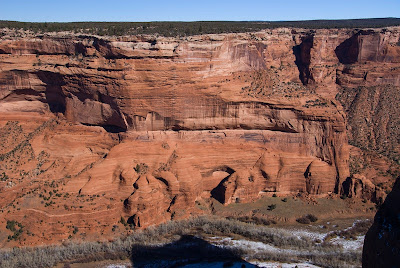I am revisiting Sedona, AZ and am joined by my brother and sister-in-law. I am doing some photography, but I am more focused on hosting their visit.
While here, I have asked about, and thought about the phenomenon known as "energy vortexes" for which this area is so well known. As explained to me by a resident and guide, the energy vortexes are concentrations of energy that are focused upward by the shape and substance of the rocks here. In places, erosion has formed domes. At many of these domes the earth's magnetic field is focused by the domes to create an upward flowing vortex of energy that infuses visitors with a sense of energy and well-being.
The domes, and indeed all the rocks around here, contain concentrations of iron that turn the rock the distinctive red color. Above the red is often a layer of orange or yellow rock with varying concentrations of iron and other minerals which provides striations in the formations. Sculpting by wind and water produces the remarkable shapes that we see here.
The red rocks do contain relatively high concentrations of iron. Such does affect the earth's magnetic field. Any concentration of iron does so. In this area, however, the earth's magnetic field is primarily horizontal. A dome may alter the field somewhat, but far more effect is imposed by a pair of spires upon the channel between them than is imposed at the top of a dome. The tops of the domes are places where the iron-bearing rock has been removed, thus reducing the effect upon the magnetic field. The domes do not, can not, act as "lenses" redirecting the earth's magnetic field upward. Their effect is far too small.

We contain iron in the form of hemoglobin. Do we affect the earth's magnetic field? By some minute amount, we do but that is so small as to be unmeasurable. We do know this - our ferrous content is so small that a magnetic field a million times the concentration of the earth's has no noticeable effect on us. If you have ever had a MRI, you have experienced such a field yet your blood flow was unaltered.
Magnetometers can measure the earth's magnetic field with great precision, thus can measure differences in the magnetic field. So can a compass, but with far less precision. A compass is, however, much more sensitive to the earth's magnetic field than we are, which is why we have them and use them. The variations in the earth's magnetic field near the red rocks are not enough to noticeably affect a compass. Further, any such shift would be to the horizontal nature of the field. It is certainly not turned vertical by such minute amounts of iron, regardless of the shapes of the rocks.

When I stood on top of Sentinel Dome in Yosemite my spirit was infused with peace and joy. When I stood in a grove of Sequoias, I again was infused with peace and joy. I have felt this in many places I have visited - a spring in Missouri or Florida, a waterfall in North Carolina, a tidal basin or pond in Maine, a powerful river racing through a gorge in Oregon, an unbelievably blue lake atop an extinct volcano in Oregon… I think we all feel that outflow of tension and inflow of peace when we allow ourselves to rejoin nature, whether for a minute or an hour. It renews our spirit. I doubt, however, that each of these places was an energy vortex. They do help me set aside the troubles that normally rest upon all our shoulders and bear us down.
That does NOT mean that it is a force of nature, an energy vortex as it were. I think it is a life force within us, which gets trapped by the trammels of our culture and civilization. If we hear about, and believe in such things as energy vortexes, and we travel to a place like Sedona, then climb to the top of a dome hoping and expecting to experience an energy vortex, we will feel a flowing of energy and we will believe that it comes from an external source, perhaps the realignment of the earth's magnetic field. Our psyche will assure that our expectations and preconceptions are fulfilled. If we have a basic understanding of science and come to Sedona with no expectations of energy vortexes, we can still climb to the top of a dome and sit and allow ourselves to feel renewed without the need for an imaginary energy vortex. I believe that that such renewal comes from inside, not from external energy vortexes.
Are there energy vortexes here? Science can almost never prove a negative, so I can not say no. All I can say is that there is no indication, at least to me, that there are such, either here or anywhere. Maybe someday, science will find some measurable force that travels upward through the earth, and is focused into a vortex by a dome of red rock. Until then, I will be content with simply enjoying the beauty that is around me, without the need to invest it with some supernatural energy fields.
If you want to feel renewed, get out to nature and immerse yourselves in it. If you want to experience a more intense concentration of the earth's magnetic field, get in your car. That, at least, has enough ferrous concentration to affect a compass needle.
Me? I will just relax and enjoy the beauty.





































